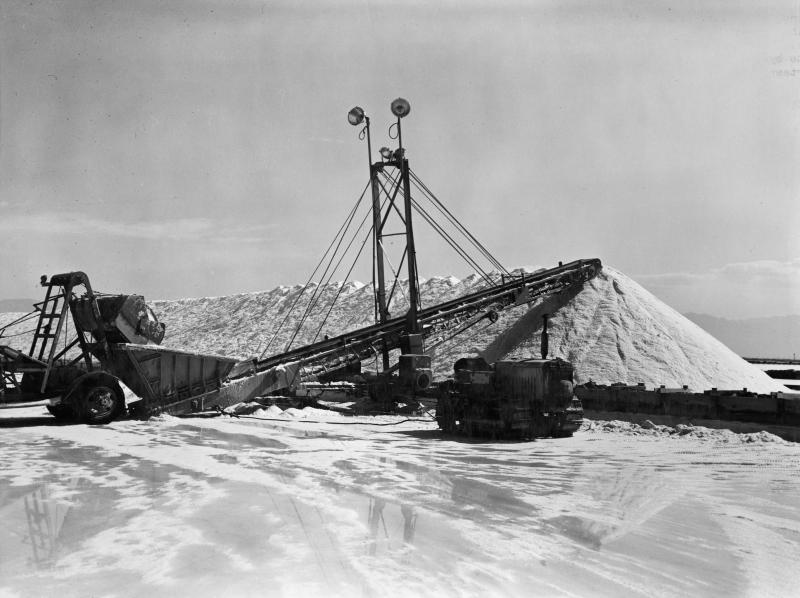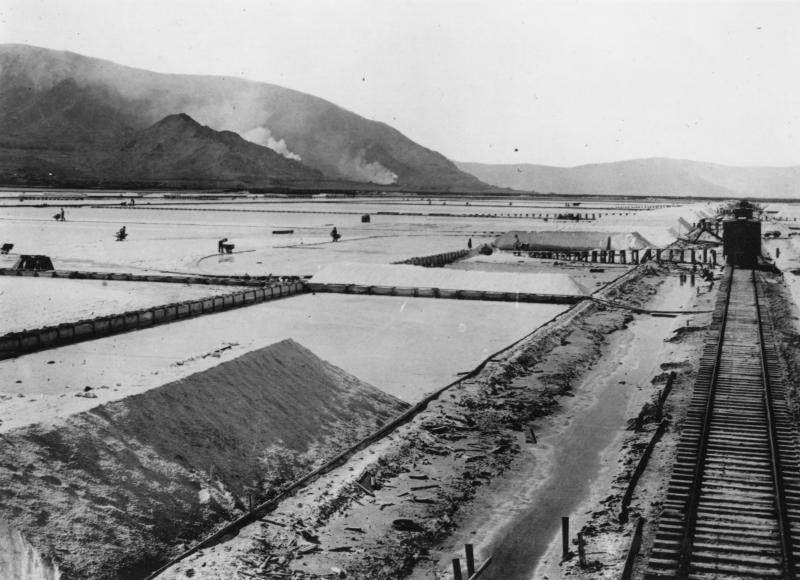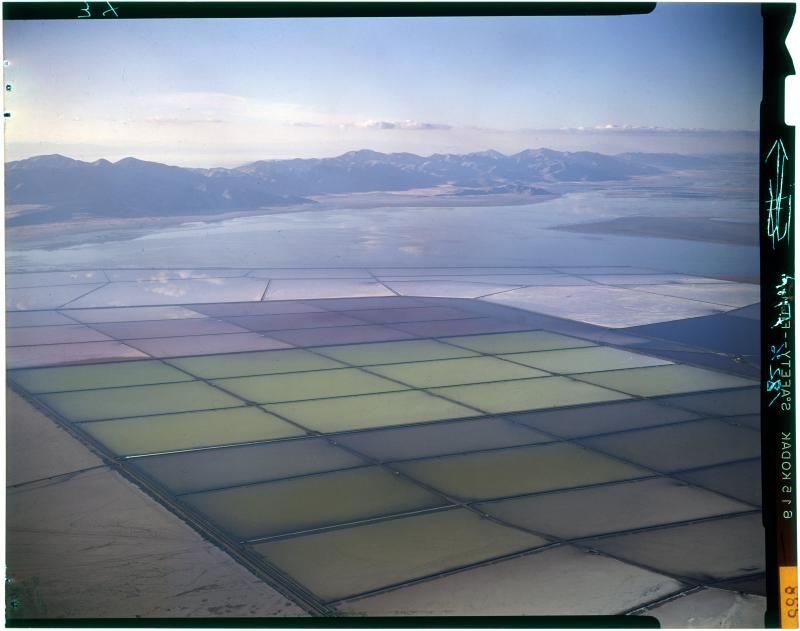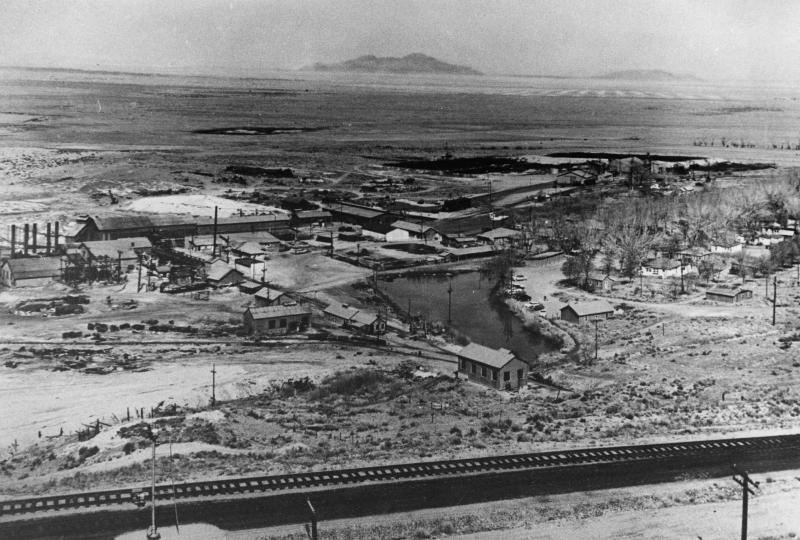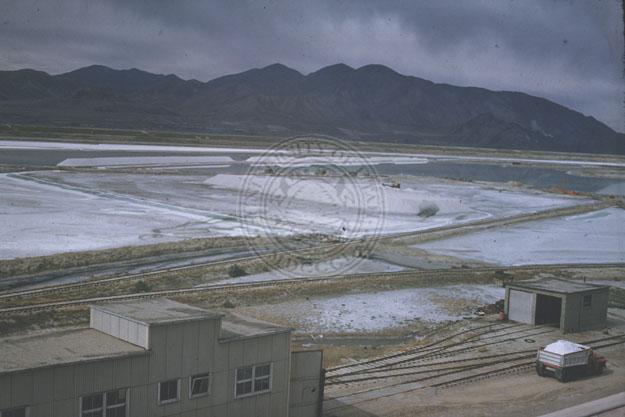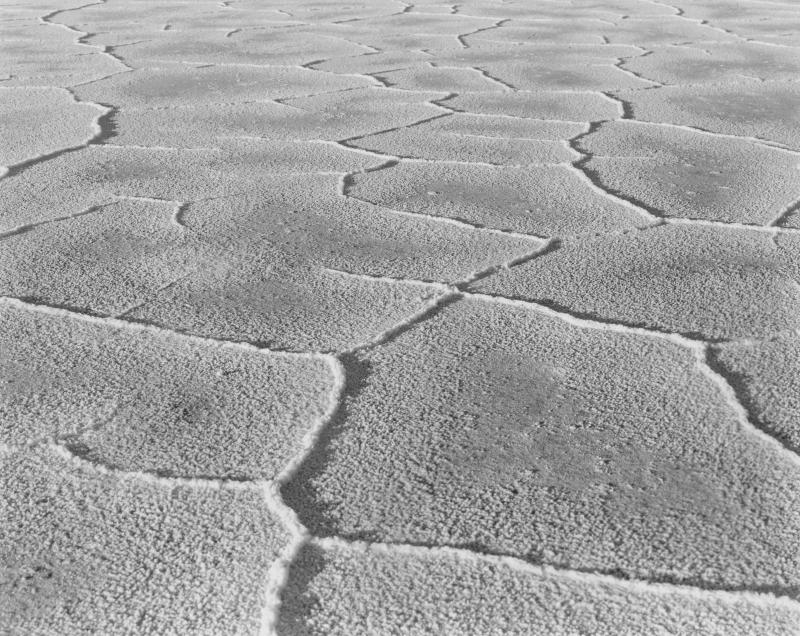Mineral Industries
Since time immemorial, the Great Salt Lake has been a resource for Utah peoples looking to gather salt and other minerals. A history of early salt manufacturing is provided by John L. Clark in “The Mormon Church and Utah Salt Manufacturing, 1847-1918”. Through the 20th Century, the scale of the extraction grew, with new industries developing to harvest the Magnesium, Potassium, and other metals and minerals of this endorheic basin. Today, according to the Great Salt Lake Ecosystem Program, the lakebed is home to 100,000 acres of solar evaporation ponds, which earns the corporations leasing this public property close to $300 million, every year.
Salt Refining-- Water is pumped from the Great Salt Lake into large concentration ponds where the salt, averaging 99.5% pure is precipitated by solar evaporation. Salt is loosened by tractor-drawn plows piled in long mounds for curing and later hauled to the mill for refining and packing. Credit: Utah Tourist & Pub. Used in Utah Historical Quarterly, Summer, 1963. Photo by: Hal Rumel. From Classified Photograph Collection, Copyright Utah State Historical Society.
Bauer/Combined Metals Reduction Company, Circa 1923. Located about 8 miles south of Tooele and looking northwest toward Stansbury Island. Water from the Honorine drain tunnel supported one of the largest apricot, peach and apple orchards in the state. For a number of years carloads of fruit were shipped out. Today the water and orchards are gone, as well as the trees in the Stockton area that were cut during early settlement years for charcoal smelters. Gift of Grant Anderson. From Classified Photograph Collection, Copyright Utah State Historical Society.
Click here for the full oral history with Genevieve Atwood and Don Mabey
Genevieve Atwood and Don Mabey discuss their involvement with the Great Salt Lake. They talk about their early experiences with the lake, and when and why they became interested in it. They describe their educational training and interests in science. Atwood discusses her career with the Utah Geological Survey, her contribution to several boards involved with the Great Salt Lake, and her time in the Utah State Legislature. She describes many of the lake’s important historical and geographical features, and the lake’s processes. She talks about her involvement in the management of the lake. Don talks about his work helping manage and plan for the Great Salt Lake. Atwood discusses the high lake level times, as well as many of the plans to control the lake level. In the second interview, Atwood talks about the causeway and its effects on the Great Salt Lake. She discusses the high lake level years. She describes the map of the Great Salt Lake that she, Mabey, and Don Currey designed and produced. Atwood talks about leaving the UGS and her time in the state legislature. She talks about the management of Great Salt Lake. She details the educational work she does with teachers and students about and at the Great Salt Lake. Don and Genevieve talk about their favorite places and experiences at the Great Salt Lake.
Click here for the full oral history with Matt Coolidge
In this interview, Matt Coolidge describes his early travels in and experiences of the west. He talks about becoming involved with art. Matt discusses founding the Center for Land Use Interpretation in Wendover. He lists the people involved in the beginning, as well as the process of starting the organization. He describes the Center and its environment. He also talks about some of the artists who have been residents, the work they’ve done, and describes the residency itself. Through CLUI, Matt is also involved with centers and programs across the country. He details the center’s exploration of the Great Salt Lake area. He describes the Great Salt Lake Land Scan and the process of creating it. Matt then discusses artists who have worked at and around Great Salt Lake, specifically Robert Smithson and Nancy Holt. At the end of the interview, he gives the interviewers a tour of CLUI while talking about land use issues relevant to the west.
Click here for the full oral history with Matt Coolidge
In this clip, Matt Coolidge talks further about the Land Scan and the MagCorp evaporation ponds.
Click here for the full oral history with J. Wallace Gwynn
Dr. Gwynn was employed by the Utah Geological Survey (UGS) for thirty-four years as the primary geologist assigned to the Great Salt Lake. In this interview, Dr. Gwynn talks about his experience working with the UGS, as well as his work at the Great Salt Lake. Topics include brine shrimp, lake minerals, salt mining, oil exploration, and the impact of the mid-1980 high water years on the lake and his work. Dr. Gwynn edited two anthology publications on the Great Salt Lake Great Salt Lake: a scientific, historical and economic overview, published in 1980, and Great Salt Lake: an overview of change, published in 2002. Dr. Gwynn received Bachelor’s Degree and PhD from the University of Utah in mineralogy and allied fields. He worked for a few years in industry before joining the UGS.
Click here for the full oral history with J. Wallace Gwynn
In this clip, J. Wallace Gwynn discusses industrial expansion on the Lake.
Click here for the full oral history with J. Wallace Gwynn
In this clip, J. Wallace Gwynn discusses the damage caused by the flooding of the mid-1980s high water.
Click here for the full oral history with John Horel
Dr. Horel was born and raised in Eureka, California. He attended Humboldt State, received his bachelor’s degree from San Jose State, and a PhD in meteorology from the University of Washington. He worked as an assistant research professor at Scripps Institute of Oceanography before joining the faculty at the University of Utah. His research interests include weather and climate of the western United States, data assimilation, fire weather, Great Salt Lake studies, cold air pools, and periods of poor air quality in valleys and basins. In this interview, Dr. Horel talks about the combination of weather and atmospheric effects influenced by the Great Salt Lake and the Wasatch Mountains. He relates personal experiences he has had with the Lake. He also talks about his work with the National Weather Service and other entities during the 2002 Winter Olympics held in Salt Lake City.
Click here for the full oral history with Robert Leroy Baskin
This clip comes from a series of two interviews focusing on Rob Baskin’s work with Great Salt Lake. Mr. Baskin was born in Montclair, New Jersey, and grew up in the small town of Branchville. His parents were school teachers, and his father was also a seasonal ranger at Yellowstone National Park. Each summer for most of Mr. Baskin’s life, he traveled West with his family for their summer job. Mr. Baskin graduated from Thiel College in Pennsylvania with a Bachelor’s of Arts degree in geology. He received his Master’s degree in geography from the University of Utah. His thesis work involved a thermal imaging project of the Great Salt Lake. He started working for the Utah office of the USGS while still a student, and accepted full-time employment there upon graduation. In this interview, he discusses his considerable scientific work on the Great Salt Lake.


